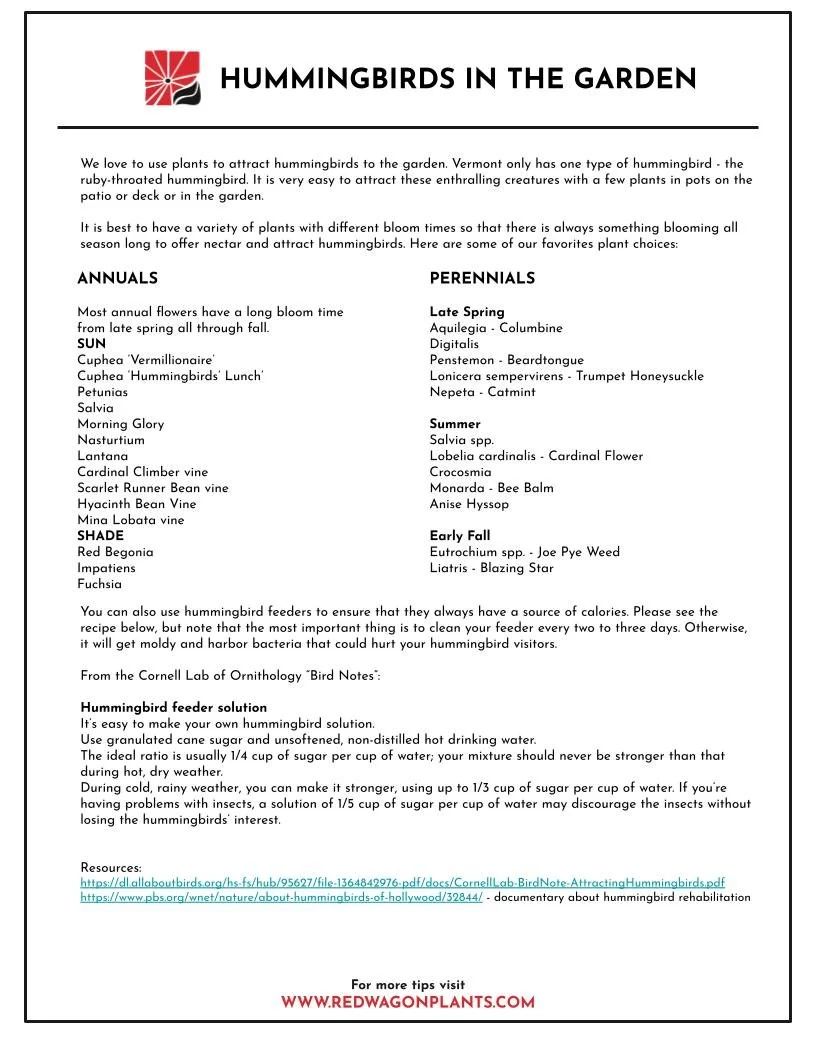Pollinator Habitat Restoration for the Home Gardener, Part 2: Butterflies and Hummingbirds
By Hope Johnson (Part 2 of a series. See Part 1 to learn about promoting bee habitat)
Of 339 species of hummingbirds, only two inhabit the area East of the Mississippi-the very rare Rufous and common Ruby-throated hummingbirds. There are many butterfly species in our state (see Vermont Center for Ecostudies’ Vermont Butterfly Survey and The Butterfly Site’s List of Butterflies of Vermont).
Both Hummingbirds and butterflies are attracted to nectar-rich flowers. Butterflies prefer purple and yellow flowers and hummingbirds are attracted more to red and blue. Site your nectar plants in an open area of the yard, and be sure to include host plants which provide forage for caterpillars. Remember, some butterflies don’t live on nectar from flowers but instead feed on soft and over-ripe fruit. (See The Nature Conservancy’s Gardening with Vermont Native Plants.)
Wondering what to plant? Here's a list of Top Ten flowers for Hummingbirds and Butterflies:
1. Yellow cosmos
2. Phlox: Meadow phlox, P. maculata and Garden phlox P. paniculata.
3. Cardinal flower, Lobelia cardinalis
4. Goldenrods, Solidago spp., attract monarchs.
5. Butterfly weed, Asclepius tuberosa.
6. Purple coneflower, Echinacea purpurea.
7. Columbines, Aquilegia spp.
8. Scarlet sage, Salvia splendens.
9. Red buckeye, Aesculus pavia, small tree.
10. Spiderflower, Cleome.
What else do butterflies and hummingbirds need? Water! Hummingbirds naturally use the smooth leaves of deciduous trees such as dogwoods, eastern redbud and sugar maple as birdbaths, but also appreciate misting sprinklers. For drinking, butterflies require a thin film of water such as around puddle edges or in slight depressions on rock surfaces.
What else can we do to provide habitat? Butterflies roost in trees and some hibernate in the winter. Leave sites for overwintering such as sheltered spots where caterpillars or pupae can survive the cold weather. Leaf and plant debris shelter chrysalises and pupae and provide a hibernation box in areas devoid of natural debris. Native shade trees provide protection from hot sun, heavy winds and driving rain. Consider a hedgerow for protection from prevailing winds. Perennials with wide leaves such as hosta provide cover for butterflies. In the East, nest sites for hummingbirds include common native trees such as oaks, hickories junipers, hemlocks and pines. Open branching shrubs such as spicebush (Lindera benzoin), hawthorns (Crataegus spp) and willow (Salix spp) are preferred for perching sites. You can provide a source of nesting materials by putting out a suet feeder filled with natural fibers such as cotton fluff and small feathers.
Lastly, avoid use entirely of insecticides in gardens intended for butterflies. These include malathion, Sevin and diazinon. Bacillus thuringiensis is lethal to caterpillars. Most butterfly caterpillars do not cause the leaf damage like that made by tent caterpillars and gypsy moths. Let those butterfly caterpillars do their thing and watch as these pollinators enjoy your garden!
References
Attracting Native Pollinators: Protecting North America’s Bees and Butterflies, The Xerces Society Guide, Storey Publishing, 2011.
Attracting Butterflies and Hummingbirds to Your Backyard, Roth, Sally. Rodale, Inc., 2001.
Website: How to Attract Butterflies to Your Garden, National Wildlife Federation, nwf.org.



